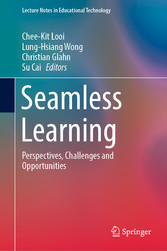
Seamless Learning - Perspectives, Challenges and Opportunities
von: Chee-Kit Looi, Lung-Hsiang Wong, Christian Glahn, Su Cai
Springer-Verlag, 2019
ISBN: 9789811330711
Sprache: Englisch
214 Seiten, Download: 4802 KB
Format: PDF, auch als Online-Lesen
| Preface | 6 | ||
| Contents | 9 | ||
| Editors and Contributors | 11 | ||
| Theoretical Niches and Frameworks for Seamless Learning | 14 | ||
| 1 The Conceptual Niche of Seamless Learning: An Invitation to Dialogue | 15 | ||
| 1 Introduction | 15 | ||
| 2 The Key Concept and the Theoretical Basis of Seamless Learning | 17 | ||
| 3 The Relationships Between Seamless Learning and Other Relevant Learning Approaches | 18 | ||
| 3.1 Blended Learning | 18 | ||
| 3.2 Self-Directed Learning (SDL)/Self-Regulated Learning (SRL) | 19 | ||
| 3.3 Lifelong Learning (LLL) and Heutagogy | 20 | ||
| 3.4 Crossover Learning | 22 | ||
| 3.5 Long-Tail Learning | 23 | ||
| 3.6 Wildfire Activities | 24 | ||
| 3.7 Free-Choice Learning | 26 | ||
| 3.8 Third Space Learning | 27 | ||
| 4 Well-Known Learning Approaches Go Seamless | 28 | ||
| 4.1 Seamless Flipped Learning | 28 | ||
| 4.2 Seamless Knowledge Building | 29 | ||
| 4.3 Seamless Task-Based (Language) Learning | 30 | ||
| 5 Discussion and Conclusion | 31 | ||
| References | 33 | ||
| 2 The Learning Problems Behind the Seams in Seamless Learning | 40 | ||
| 1 Introduction and Problem Statement | 40 | ||
| 2 Problem Analysis I: Differences in Contexts, Modalities, and Output/Outcome | 43 | ||
| 2.1 Underlying Differences of Different Context Aspects | 44 | ||
| 2.2 Underlying Differences of Different Learning Modalities | 46 | ||
| 2.3 Underlying Differences of Different Output/Outcomes | 49 | ||
| 3 Problem Analysis II: Differences in the Understanding of Learning Processes and Learning Aims | 52 | ||
| 3.1 Learning Process | 52 | ||
| 3.2 Differences in Regard to Learning Aims | 52 | ||
| 4 Learning Strategies—A Necessary Component in the Seamless Learning Approach | 55 | ||
| 5 On the Way to Seam-Aware Learning Design Principles | 56 | ||
| 6 Conclusion | 59 | ||
| References | 59 | ||
| 3 External Representations and the Design of Seamless Learning Systems | 63 | ||
| 1 Introduction | 63 | ||
| 2 Seamless Learning | 65 | ||
| 3 External Representations | 66 | ||
| 4 Challenges Applying External Representations to Seamless Learning Systems | 69 | ||
| 4.1 Physical Form Factor and Interactional Qualities | 69 | ||
| 4.2 Social Settings and Contexts | 71 | ||
| 4.3 Physical Space and Context | 72 | ||
| 5 Designing ERs for Shifting Contexts | 73 | ||
| 5.1 Minimize the Impact of Shifting Devices and Interaction Techniques | 74 | ||
| 5.2 Smooth Discontinuities Between Social Settings | 75 | ||
| 6 Methodological Challenges When Evaluating Seamless Learning Scenarios from an ERs Perspective | 76 | ||
| 7 Conclusions | 77 | ||
| References | 78 | ||
| 4 An Inspiration from Border Crossing: Principle of Boundary Activity for Integrating Learning in the Formal and Informal Spaces | 83 | ||
| 1 Introduction | 83 | ||
| 2 Literature | 84 | ||
| 2.1 Science Learning in Informal Spaces | 84 | ||
| 2.2 Connecting Formal and Informal Learning | 85 | ||
| 3 Theoretical Foundations | 87 | ||
| 3.1 The Conception of Boundary Object | 87 | ||
| 3.2 The Principle of Boundary Activity-Based Learning | 88 | ||
| 4 BABL Guided Seamless Learning: Case Study | 91 | ||
| 4.1 Mediating Tools of BABL Seamless Learning | 91 | ||
| 4.2 Lesson Exemplar | 93 | ||
| 4.3 Feedback from Students and Their Teacher | 94 | ||
| 5 Conclusion | 95 | ||
| References | 96 | ||
| Architectures and Technologies for Supporting Seamless Learning | 99 | ||
| 5 Towards an Architectural Approach to Supporting Collaborative Seamless Learning Experiences | 100 | ||
| 1 Introduction | 100 | ||
| 2 Towards Collaborative Seamless Learning Across Contexts | 102 | ||
| 3 CSL Cases | 105 | ||
| 3.1 Case 1: Usability Issues | 105 | ||
| 3.2 Case 2: LETS GO | 107 | ||
| 3.3 Case 3: Interactive Videos | 108 | ||
| 4 Mapping the Educational, Organizational and Technological Dimensions of the Described Cases | 109 | ||
| 5 The Proposed Approach to Designing CSL Activities | 111 | ||
| 6 From Design to Technological Deployment of CSL Activities | 113 | ||
| 7 Summary and Conclusions | 115 | ||
| References | 117 | ||
| 6 Crossing Over Settings, Practices and Experiences: Connecting Learning in Museums and Classrooms | 120 | ||
| 1 Introduction | 120 | ||
| 2 Theoretical Background | 122 | ||
| 2.1 Mobile Pedagogy for Crossing Over Museum and Classroom Learning Experiences | 122 | ||
| 2.2 How Mobile Technologies May Support Crossover Learning Experiences? | 123 | ||
| 2.3 How Mobile Devices Are Used Within and Beyond the Museum? | 125 | ||
| 3 Research Context | 126 | ||
| 3.1 Aims and Objectives | 126 | ||
| 3.2 Tools | 127 | ||
| 3.3 Participants | 127 | ||
| 3.4 School and Museum Activities | 127 | ||
| 3.5 Methods and Data Collected | 129 | ||
| 4 Enabling Mobile Pedagogy for Learning Across Contexts | 132 | ||
| 4.1 Pedagogy #1: Live Communication with a Museum Curator (Pre-visit) | 132 | ||
| 4.2 Pedagogy #2: Temporal and Spatial Arrangements (Visit) | 135 | ||
| 4.3 Pedagogy #3: Engaging Learners in Active Learning: Presentations and Peer Review Activity (Post-visit) | 137 | ||
| 5 Discussion | 139 | ||
| 6 Conclusion: Towards a Mobile Pedagogy for Crossover Learning | 143 | ||
| References | 144 | ||
| Expositions and Experimentations of Seamless Learning | 147 | ||
| 7 Sensors for Seamless Learning | 148 | ||
| 1 Introduction | 148 | ||
| 2 Linking Sensor-Based Interaction and AR | 151 | ||
| 3 Design Patterns in AR Learning Experiences | 155 | ||
| 4 Discussion and Conclusion | 157 | ||
| References | 157 | ||
| 8 Designing Seamless Learning Activities for School Visitors in the Context of Fab Lab Oulu | 160 | ||
| 1 Introduction | 160 | ||
| 2 Computational Thinking and Computational Making in Makers Contexts | 162 | ||
| 3 Design-Driven Education as a Model for Teaching Twenty-First-Century Skills in Makers Contexts | 164 | ||
| 4 How is Seamless Learning Present in the Context of the Fab Lab Oulu? | 166 | ||
| 4.1 Example 1: Fab4School, An Example of No Seamless Learning Design | 166 | ||
| 4.2 Example 2: A Fully Seamless Learning Design | 167 | ||
| 5 Conclusions | 172 | ||
| References | 174 | ||
| 9 Supporting Seamless Learning with a Learning Analytics Approach | 177 | ||
| 1 Introduction | 177 | ||
| 2 Related Research | 179 | ||
| 2.1 Learning Analytics | 179 | ||
| 2.2 Seamless Learning | 181 | ||
| 3 SCROLL, AETEL, VASCORLL | 182 | ||
| 3.1 SCROLL | 182 | ||
| 3.2 AETEL (eBook System) | 183 | ||
| 3.3 VASCORLL | 184 | ||
| 4 Empirical Study with VASCORLL | 186 | ||
| 4.1 Method | 186 | ||
| 4.2 Results and Discussion | 189 | ||
| 5 Conclusions and Future Work | 193 | ||
| References | 194 | ||
| 10 Seamless Writing: How the Digitisation of Writing Transforms Thinking, Communication, and Student Learning | 197 | ||
| 1 Introduction | 197 | ||
| 2 Seams and the Development of Digital Writing Technology | 201 | ||
| 2.1 Personal Computers and Word Processors: The Big Bang of Digital Writing | 201 | ||
| 2.2 Computer Laboratories: New Writing Opportunities, yet an Immobile Technology | 202 | ||
| 2.3 Internet and E-Mail: Removing the Seam Between Writing and Communication | 203 | ||
| 2.4 Learning Platforms: Starting the Age of Virtual Teaching and Blended Learning | 204 | ||
| 2.5 Social Media: Community Building the Digital Way | 204 | ||
| 2.6 Laptop, Tablet, Smartphone et al.: Learning Becomes Mobile | 205 | ||
| 2.7 Document Sharing and Collaborative Writing: One Text, Many Writers | 205 | ||
| 2.8 Automated Feedback, Intelligent Tutoring, and Digital Scaffolding: Reconnecting Writing and Instruction | 206 | ||
| 3 Thesis Writer: An Example of a Seamless Writing Environment | 206 | ||
| 4 Conclusion | 211 | ||
| References | 213 |








